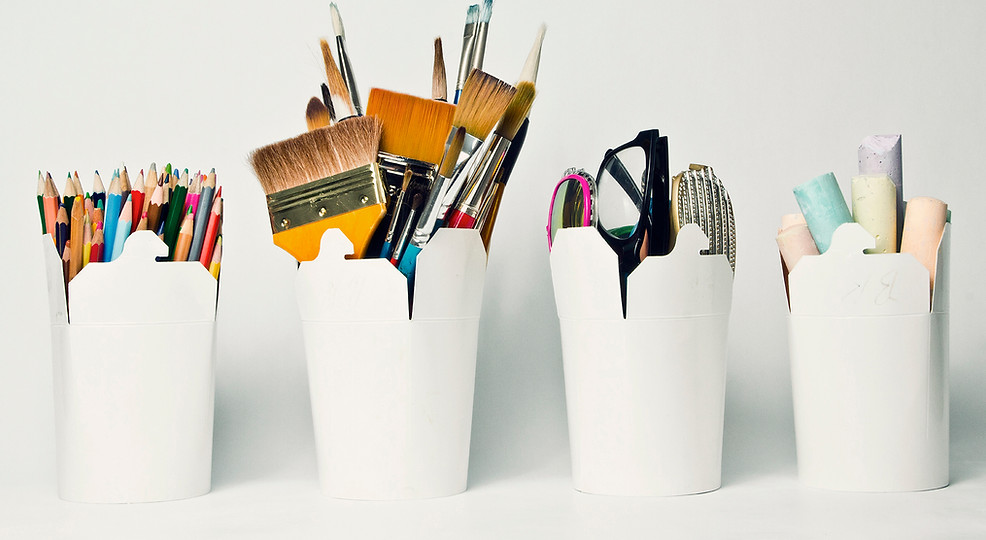Um, Copyright is for Humans Only
- copyrightforcrafte
- Feb 25, 2022
- 4 min read
Updated: Apr 15, 2022

Before the recent past, it might have been unnecessary to explain that, in order to be eligible for copyright protection, the work in question must be created by a human being. But, oh how things have changed.
Works Created by Machines
The above photo is called "A Recent Entrance to Paradise." If someone had painted this or used digital software to create it, it would almost certainly be eligible for copyright protection. But, this piece was "autonomously created by a computer algorithm running on a machine[.]" [1] The science behind this machinery is well beyond my capacity to understand or explain....I tried so hard to follow how this algorithm worked but alas....
Anyway, the man behind the machine, Dr. Stephen Thaler, tried to register a copyright in the work in November 2018 and was denied. From then until February 2022, he and the Copyright Office swapped letters back and forth as Dr. Thaler appealed the registration denial multiple times.
On the registration form, Dr. Thaler listed the author of the image as "The Creativity Machine," listed himself as the owner of the machine and wanted the picture to be deemed a "work-for-hire." [2] A "work-for-hire" is "a work prepared by an employee within the scope of his or her employment or...a work specially ordered or commissioned" for certain uses. [3] In work-for-hire situations, the employee or contractor does the work and the business or the person paying for the commission owns the copyright. So...apparently Dr. Thaler is arguing that the Creativity Machine should be treated as if it is just doing a work pursuant to his instructions like an employee. Additionally, he mentions that limiting copyright ownership to "humans only" is unconstitutional and that there is no binding authority which actually states that copyright cannot attach to machine generated works of art.
The Copyright Office pushed back on Dr. Thaler's assertions stating that copyright only protects “the fruits of intellectual labor” that “are founded in the creative powers of the [human] mind.” [4] The Copyright Act never contemplated offering protection to the works of machines; machine's rights is not the reason the Founders included copyright in the Constitution. Promoting creativity by machines is not why copyright is in our Constitution.
The Copyright Office reiterated that, in determining whether rights will attach "the crucial question appears to be whether the “work” is basically one of human authorship, with the computer merely being an assisting instrument, or whether the traditional element of authorship in the work (literary, artistic or musical expression or elements of selection, arrangements, etc.) were actually conceived and executed not by man but by a machine." [5]
The concept put forth by the Copyright Office makes sense when you look at machines like, for instance, a Cricut or Silhouette Cameo. These are both digital cutting machines that physically cut out a finished product, usually from paper. But, the difference between these machines and The Creativity Machine is that a Cricut or Cameo do not choose what they cut out. Although my Cameo has definitely seemed like it had a mind of its own many times, it can only cut a design that is created and arranged by a human user. Ultimately, and the Copyright Office agreed, the law simply does not contemplate offering protection to a machine which operates sans that human touch.
No Animals Either
The "work-for-hire" argument made by Dr. Thaler is a familiar one because corporate copyright ownership was also mentioned by the People for the Ethical Treatment of Animals (“PETA”) in the Naruto et al v. David Slater case...Otherwise known as the "Monkey Selfie" case.

In 2011, David Slater, a wildlife photographer, traveled to Indonesia to photograph a group of macaque monkeys. At one point, Slater left his camera unattended in the reserve and a monkey, Naruto, took several photos of himself using Slater’s camera. These photos, dubbed the “Monkey Selfies,” an example of which is shown here, were later published in a book wherein Slater claimed to be the owner of the copyright.
In 2015, PETA filed a lawsuit against Slater on behalf of Naruto the monkey claiming that Naruto was the true owner of the “Selfies” copyright. During the course of that litigation, PETA pointed out the fact that Congress already allows non-humans to own copyrights as is the case with the "work-for-hire" doctrine and corporate copyright ownership. [6] This argument wasn't super persuasive as it ignores the reality that there are actual human beings doing the creating behind the corporations. In other words, a corporation is just an "aggregate of individuals [who] have legal personhood" unlike a monkey or a machine. [7] The monkey case was ultimately thrown out and it was determined that animals did not have a right to sue under the Copyright Act. [8]
The Takeaway for Crafters
What you should take away from this is...its good to be a person. That and a deeper understanding of the key and central concept of authorship as found in the Copyright Act. To be considered an author of a work, said work not only has to demonstrate intellectual labor and creative spark but that labor and spark must originate from the brain of a person. Sure, a machine - like a 3D printer, a camera, a drone, a Cricut, etc. can help execute a vision but, in order to own a copyright, the original creative input has to have that special human touch.
[2] Id.
[5] Id.
[6] Plaintiff Naruto’s Combined Opposition to Defendants’ Motion to Dismiss, Naruto v. Slater, No. 15-CV-04324-WHO, 2016 WL 362231 (N.D. Cal. Jan. 28, 2016) (15-cv-4324- WHO), 2015 WL 9392544.
[8] Naruto v. Slater, 888 F.3d 418 (9th Cir. 2018).

Comments